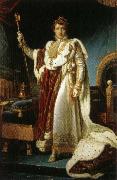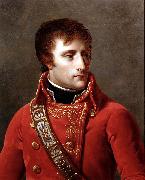
|
Francois Gerard
|
|||
|
|
|||
| French Neoclassical Painter, 1770-1837 was a French painter born in Rome, where his father occupied a post in the house of the French ambassador. His mother was Italian. François Gerard was born in Rome, on 12 March 1770, to J. S. Gerard and Cleria Matteï. At the age of twelve Gerard obtained admission into the Pension du Roi in Paris. From the Pension he passed to the studio of the sculptor Augustin Pajou which he left at the end of two years for that of the history painter Nicolas-Guy Brenet, whom he quit almost immediately to place himself under Jacques-Louis David. In 1789 he competed for the Prix de Rome, which was carried off by his comrade Girodet. In the following year (1790) he again presented himself, but the death of his father prevented the completion of his work, and obliged him to accompany his mother to Rome. In 1791 he returned to Paris; but his poverty was so great that he was forced to forgo his studies in favor of employment which should bring in immediate profit. David at once availed himself of his help, and one of that master's most celebrated portraits, of Le Pelletier de St Fargeaumay, owes much to the hand of Gerard. This painting was executed early in 1793, the year in which Gerard, at the request of David, was named a member of the revolutionary tribunal, from the fatal decisions of which he, however, invariably absented himself. In 1794 he obtained the first prize in a competition, the subject of which was The Tenth of August, and, further stimulated by the successes of his rival and friend Girodet in the Salons of 1793 and 1794, Gerard (nobly aided by Jean-Baptiste Isabey, the miniaturist, produced in 1795 his famous Belisaire. In 1796 a portrait of his generous friend (in the Louvre) obtained undisputed success, and the money received from Isabey for these two works enabled Gerard to execute in 1797 his Psyche et l'Amour (illustration). At last, in 1799, his portrait of Madame Mere established his position as one of the first portrait-painters of the day. In 1808 as many as eight, in 1810 no less than fourteen portraits by him, were exhibited at the Salon, and these figures afford only an indication of the enormous numbers which he executed yearly; all the leading figures of the Empire and of the Restoration, all the most celebrated men and women of Europe, sat to Gerard. This extraordinary vogue was due partly to the charm of his manner and conversation, for his salon was as much frequented as his studio; Madame de Staël, George Canning, Talleyrand, the Duke of Wellington, have all borne witness to the attraction of his society. Rich and famous, Gerard was stung by remorse for earlier ambitions abandoned; at intervals he had indeed striven to prove his strength with Girodet and other rivals, and his Bataille d'Austerlitz (1810) showed a breadth of invention and style which are even more conspicuous in L'Entree d'Henri IV Paris (at Versailles), the work with which in 1817 he did homage to the Bourbons. After this date Gerard declined, | |||
|
|
|||
|
Portrait of Napoleon Bonaparte new4/Francois Gerard-465672.jpg Painting ID:: 30669 |
mk68 Oil on canvas Capidomonte Museum 1807 France | ||
|
|
|||
|
Baron Antoine-Jean Gros
|
|||
|
|
|||
| 1771-1835 French Baron Antoine-Jean Gros Galleries The son of a painter, Antoine Jean Gros was born in Paris on March 16, 1771. At the age of 14 he entered the studio of Jacques Louis David, the acknowledged leader of the classical revival. Although his own work became radically different from David's, he maintained a lifelong respect for his teacher and envisioned himself as the upholder of the Davidian tradition. In 1787 Gros entered the Acad??mie de Peinture, and when the Acad??mie dissolved in 1793 (a result of the French Revolution) he went to Italy. He met Josephine Bonaparte in Genoa in 1796, and she introduced him to Napoleonic society. Gros entered Napoleon's immediate entourage and accompanied him on several north Italian campaigns. Gros also became involved with Napoleon's program of confiscating Italian art for removal to France. Gros returned to Paris in 1800 and began to show his Napoleonic paintings in the annual Salons. The most famous of these are the Pesthouse at Jaffa (1804) and Napoleon at Eylau (1808). These works served to deify Napoleon, showing him engaged in acts of heroism and mercy. Stylistically, the paintings were revolutionary:their exotic settings, rich color, agitated space, and general penchant for showing the gruesome specifics of war and suffering differed radically from the cool generalizations of Davidian classicism that Gros had learned as a student. The presentation of contemporary historical events was also new, a harbinger of the realism that developed steadily during the first half of the 19th century in French, American, and English painting. Finally, the emphatic emotionalism of Gros's art established the foundation of romantic painting that Th??odore G??ricault and Eug??ne Delacroix developed after him. Unlike that of some of his countrymen (David is a case in point), Gros's position did not suffer after the fall of Napoleon. Gros painted for the restored monarchy, for instance, Louis XVIII Leaving the Tuileries (1817), and he decorated the dome of the Panth??on in Paris with scenes of French history (1814-1824). For this Charles X made him a baron in 1824. But these works lack the zest and commitment of Gros's Napoleonic period, perhaps because they were not based on the immediate kinds of historical experiences that had inspired the earlier paintings. Although marked by considerable public success, Gros's later career was in many ways acutely troubled. Basically, he could not resolve his personal esthetic theories with his own painting or with the work of his younger contemporaries. To the end Gros wished to propagate the classicism of David, and he took over David's studio when the master was exiled in 1816. By the 1820s, however, the revolutionary romanticism of G??ricault and Delacroix, among others, had clearly begun to eclipse classicism, and Gros found himself fighting a lonely and losing battle for conservatism. Ironically, he was fighting a trend that his own best work had helped to originate. As he persisted, moreover, his own painting began to show a diffident mixture of classic and romantic attitudes. Thus, while he was inherently a romantic, he tragically came to doubt himself. Gros died on June 26, 1835, apparently a suicide. | |||
|
|
|||
|
Portrait of Napoleon Bonaparte new26/Baron Antoine-Jean Gros-637836.jpg Painting ID:: 95441 |
Portrait of Napoleon Bonaparte | ||
|
|
|||
|
Also Buy::. For Following Paintings / Artists / Products, Please Use Our Search Online: |









